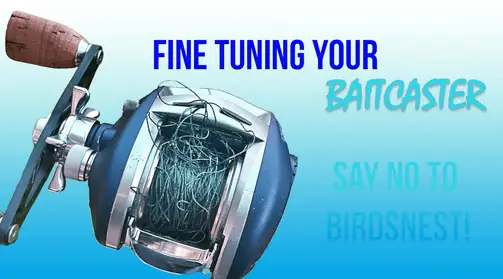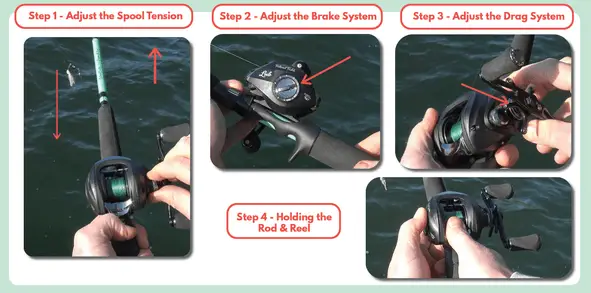Learn how to tune a baitcaster with the help of my lesson. This step by step guide is very simple and helpful.
How to Tune a Baitcaster Reel
To tune a baitcaster, adjust the brakes and tension knob until the spool spins smoothly without backlashing. To begin, remove the spool tension knob and adjust the brake dial to a medium setting.
Slowly to tighten the spool tension knob until your lure landing slowly when the reel is in free spool, then fine-tune the brakes to prevent backlashes during casting. With proper tuning, you can improve your casting distance and accuracy, making your baitcasting experience more enjoyable.
So, let’s dive into the details of how to tune a baitcaster and improve your fishing performance.
Importance Of Properly Tuning A Baitcaster
Properly tuning a baitcaster reel is of utmost importance for any angler, whether they are a seasoned pro or a beginner just starting out. The way you set up and tune your baitcaster can greatly affect your casting accuracy, as well as prevent backlashes and bird’s nests that can ruin your fishing trip. Understanding how to tune your baitcaster will not only improve your overall fishing experience but also help you achieve better casting distance and accuracy.
Improves Casting Accuracy
Properly tuning your baitcaster reel is key to improving casting accuracy. When your baitcaster is tuned correctly, it allows for precise control over the speed and distance of your cast. This means you can pinpoint your lure or bait exactly where you want it to go, whether it’s right along the shoreline or in a specific spot in the water. With improved casting accuracy, you increase your chances of enticing fish and ultimately reeling in a successful catch.
Prevents Backlashes And Bird’s Nests
Tuning your baitcaster also plays a crucial role in preventing backlashes and bird’s nests. Backlashes occur when the spool of your baitcaster spins faster than the line coming off, causing the line to tangle and create a mess known as a backlash. These tangles not only waste valuable fishing time, but they can also be Disappointing to without tangles and may lead to lost fishing lures. By properly tuning your bait caster, you can ensure the spool spins at the optimal speed, reducing the chances of backlashes and bird’s nests.
Preventing backlashes and bird’s nests not only saves you time and loss but also helps in maintaining a smooth and uninterrupted fishing experience. Imagine casting your lure effortlessly without worrying about line tangles, allowing you to focus on fishing rather than obtaining knots out of your fishing line.
In conclusion –
Tuning your baitcaster is an essential step in optimizing your fishing performance. By improving casting accuracy and preventing backlashes and bird’s nests, you can enjoy a more productive and enjoyable fishing experience. So, take the time to properly tune your baitcaster before hitting the water, and get ready to hook into your next big catch!
Choosing The Right Baitcasting Reel
Discover how to fine-tune your baitcasting reel for optimal performance. Adjusting the tension and brakes can improve casting accuracy and prevent backlash issues. Understanding these adjustments is essential for successful fishing experiences.
When it comes to baitcaster reels, choosing the right one is crucial for a successful fishing experience. With a variety of options available, understanding key factors such as gear ratios and brake systems can help you make an informed decision. Let’s take a closer look at these aspects to ensure you select the perfect baitcaster reel for your needs.
Understanding Gear Ratios
One of the most important considerations when choosing a bait caster reel is the gear ratio. Gear ratio refers to the number of times the spool turns for each single turn of the handle. It directly impacts the speed at which you can retrieve your line. Baitcasting reels typically come in three main gear ratio categories – low, medium, and high.
Low gear ratio reels, ranging from 5:1 to 6:1, are ideal for slow presentations and situations where you need more power. They provide a higher torque, making them perfect for techniques like flipping and pitching, or when dealing with heavy cover.
Medium gear ratio reels, typically between 6:1 and 7:1, offer a balance between speed and power. They allow for versatility in various fishing techniques, making them a popular choice among anglers who want a balance of power and speed.
High gear ratio reels, generally 7:1 or higher, are designed for fast line retrieval. They are perfect for techniques that require a quick retrieval, such as buzzbaits or topwater lures. However, keep in mind that high gear ratios sacrifice some power, so they may not be ideal for heavy cover situations.
Considering Brake Systems
Another essential aspect to consider when choosing a baitcaster reel is the brake system. Brake systems are designed to control the spool’s rotation during casting, preventing backlashes and ensuring smooth line release. There are two main types of brake systems – magnetic and centrifugal.
Magnetic brake systems use magnets to apply pressure on the spool, slowing it down during the cast. They provide precise control and are excellent for beginners or anglers who prefer effortless adjustments. With magnetic brakes, you can easily fine-tune the reel to match your casting style or prevailing weather conditions.
Centrifugal brake systems, on the other hand, use small weights that push against brake blocks, creating friction and slowing down the spool. This type of braking system offers excellent line control and is ideal for casting in windy conditions or when using lighter baits. It provides consistent performance and is often favored by experienced anglers.
When it comes to choosing the right baitcasting reel, understanding gear ratios and brake systems are essential. Analyzing the fishing techniques you’ll be using and the conditions you’ll be fishing in can help you narrow down your options and find the perfect reel that suits your needs. Remember to consider gear ratios for speed and power, and brake systems for precise control during casting. With the right baitcasting reel, you’ll be ready to tackle any fishing adventure with confidence.
Setting Up The Baitcaster
Setting Up the Baitcaster involves key adjustments to ensure smooth casting and effective fishing. To start, it’s crucial to focus on Adjusting the Brakes and Fine-tuning the Tension Knob for optimal performance.
Adjusting The Brakes
Adjusting the brakes is essential to prevent backlash and control the speed of the spool rotation.
- Engage the brake system to a medium setting.
- Gradually loosen the brakes to find the right balance.
- Test your adjustments by casting and adjust as needed.
Fine-tuning The Tension Knob
Fine-tuning the Tension Knob is crucial for casting accuracy and preventing line snags.
- Start by setting the tension knob to a medium position.
- Adjust the knob tighter for lighter lures and looser for heavier lures.
- Test your setting by engaging the reel and adjusting until the bait drops slowly and smoothly.
Maintenance Tips For Peak Performance
Maintain peak performance for your bait caster with these expert tuning tips. Maximize efficiency and avoid common issues for optimal fishing experience.
Maintenance Tips for Peak Performance Baitcasters are essential tools for anglers, offering precision and accuracy when casting. However, to ensure they function optimally, regular maintenance is crucial. By implementing simple upkeep practices, you can prolong the lifespan of your baitcaster and maximize its performance. Here are some key maintenance tips for peak performance:
Inspecting For Wear And Tear
Regular inspections are essential to identify any potential issues with your baitcaster. Check for signs of wear on the gears, bearings, and other crucial components. Any abnormalities or damages should be addressed promptly to avoid further deterioration. Inspect the fishing line for fraying and replace if necessary to prevent potential line breakage during use. In addition, ensure that the drag system is functioning smoothly by testing it under varying tension levels. This will help maintain consistent drag performance and prevent premature wear on the system. By implementing these maintenance tips, you can keep your baitcaster in top condition, ensuring reliable performance and prolonged lifespan. Regular cleaning and lubrication, along with thorough inspections, are key to maintaining your baitcaster’s peak performance.
Frequently Asked Questions For How To Tune A Bait Caster
How Do You Adjust A Baitcaster?
To adjust a baitcaster, follow these steps: 1. Start by setting the spool tension to prevent backlash. 2. Adjust the brakes to control the rotation speed of the spool. 3. Fine-tune the drag settings to control the resistance when reeling in a fish. 4. Practice casting with different adjustments to find the sweet spot. 5. Regularly adjust the settings based on the fishing conditions and lure weight for optimal performance.
How Do You Tension A Baitcaster?
To tension a baitcaster, adjust the knob on the side plate until the bait falls slowly. Fine-tune with trial and error for optimal casting performance.
Last Word
To ensure optimal performance, follow these steps to tune your bait caster effortlessly. With practice and patience, mastering the art of tuning will improve your fishing experience. Don’t overlook the importance of a well-tuned bait caster for smooth casting and precision in your angling adventures. Thank you for reading the article on how tune a bait caster.
Happy fishing!


